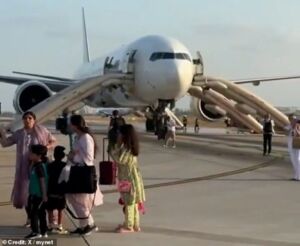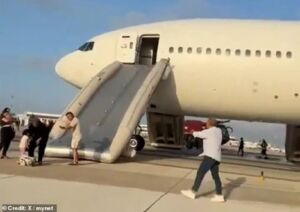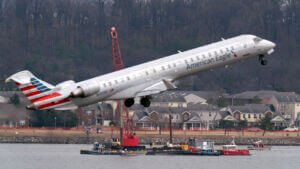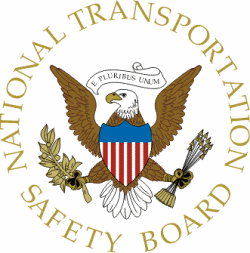These are your stories for today...
Of note, another aircraft evacuation, this time at Antalya Airport in southwestern Turkey where once again carry-on luggage seemed more important than personal safety.
Be safe out there!
Tom
Passengers are seen running across tarmac as they flee jet after 'landing gear caught fire'
By LETTICE BROMOVSKY
Passengers have been spotted running across the tarmac at an airport after the 'landing gear' of their plane caught fire.
tarmac at an airport after the 'landing gear' of their plane caught fire.
The Turkish Airlines flight departing from Istanbul at 5.25pm made an emergency landing at Antalya Airport, allegedly due to hydraulic failure.
Smoke could be seen coming out of the landing gear as it taxied along the runway before takeoff of flight TK243 from Istanbul.
Terrified holidaymakers were filmed using the emergency slides of the Boeing 777-300ER.
It has been reported that all 247 passengers and 13 crew members were safely evacuated and the aircraft was towed to a secure area.
Turkish Airlines have been approached for comment, while an investigation into the incident is ongoing.
comment, while an investigation into the incident is ongoing.
It comes two days after a different Boeing airplane departing from Denver Airport also had to issue a forced evacuation when the plane experienced an problem with its landing gear while on the runway.
Flight AA3023 bound for Miami, Florida, was preparing for takeoff when first responders were alerted about the issue on Saturday afternoon and evacuated everybody onboard the Boeing 737 MAX 8.
Video posted online showed all 173 passengers and six crew members frantically exiting the plane on a slide as smoke billowed from underneath the aircraft.
Five people were treated at the scene, while a sixth was transported to a local hospital for what has been described as a minor injury.
The plane had been scheduled to depart from Denver at 1.12pm, and the FAA said that a 'possible landing gear' incident happened during takeoff on runway 34L.
It remains unclear what exactly went wrong during takeoff, but a spokesman for American Airlines said the aircraft experienced a maintenance issue with one of its tires and had to be taken out of service to be inspected.
https://www.dailymail.co.uk/news/article-14952349/Passengers-tarmac-flee-jet-landing-gear-fire.html
NTSB launches hearings on deadly Washington collision between helicopter, passenger plane
By JOSH FUNK
Three days of investigative hearings on the deadly midair collision over Washington in January begin Wednesday and aim to reveal new insights into what caused the crash between a passenger plane and an Army helicopter that killed 67 people.
The National Transportation Safety Board will question witnesses and investigators about how the actions of the Federal Aviation Administration and its air traffic controllers and the Army may have contributed to the nation's deadliest plane crash since November 2001. It's likely too early for the board to identify the cause of the crash.
question witnesses and investigators about how the actions of the Federal Aviation Administration and its air traffic controllers and the Army may have contributed to the nation's deadliest plane crash since November 2001. It's likely too early for the board to identify the cause of the crash.
The American Airlines plane from Wichita, Kansas collided with a Black Hawk helicopter while coming into land at Ronald Reagan National Airport and was the first in a string of crashes and near misses this year that have alarmed officials and the travelling public, despite statistics that still show flying remains the safest form of transportation.
Investigations have already shown the FAA failed to recognize a troubling history of 85 near misses around Reagan airport in the years before the collision, and that the Army's helicopters routinely flew around the nation's capitol with a key piece of locating equipment, known as ADS-B Out, turned off.
Aviation attorney Bob Clifford, who is working to file one of the first lawsuits against the government next month, said he hopes NTSB will look beyond the immediate factors that caused this crash to highlight the bigger ongoing concerns in the crowded Washington airspace.
"In this particular instance, there's a much broader picture. And that is the known problems that were being ignored about an unsafe environment for the commercial aircraft to be navigating with the military aviation helicopters in the area," Clifford said.
Even though the final NTSB report won't be released until sometime next year, U.S. Sen. Ted Cruz isn't waiting to propose changes. He introduced legislation Tuesday that would require all aircraft operators to use both forms of ADS-B, or Automatic Dependent Surveillance Broadcast, the technology to broadcast aircraft location data to other planes and air traffic controllers. Most aircraft today are equipped with ADS-B Out equipment but the airlines would have to add the more comprehensive ADS-B In technology to their planes.
"There cannot be a double standard in aviation safety," Cruz said. "We should not tolerate special exceptions for military training flights, operating in congested air space."
The legislation would revoke an exemption on ADS-B transmission requests for Department of Defense aircrafts. It also would require the FAA to evaluate helicopter routes near airports and require the Army Inspector General to review the Army's aviation safety practices.
NTSB Chairwoman Jennifer Homendy said her agency has been recommending that move for decades after several other crashes.
"In 2008, we sent a letter to FAA stating the board believes that the equipage of aircraft with ADS-B In capability will provide - and I want to stress this - an immediate and substantial contribution to safety, especially during operations in and around airports," she said.
Transportation Secretary Sean Duffy said that while he'd like to discuss "a few tweaks," the legislation is "the right approach." He also suggested that the previous administration "was asleep at the wheel" amid dozens of near-misses in the airspace around Washington's airspace.
"In the past, people became complacent - leaders became complacent" Duffy said.
Homendy said the hearings over the next few days will be a "fact-finding proceeding." In addition, the NTSB will also post thousands of pages of evidence from the crash investigation online Wednesday morning.
FAA Administrator Bryan Bedford said that he expects "we're going to have some very uncomfortable conversations over the next two and a half days" but that "they need to be had in the clear light of day - and simply put the best interest of the traveling public ahead of any of our personal interests, perhaps."
The hearings in Washington will involve NTSB board members, investigators and witnesses for organizations involved in the crash. Panels will focus on military helicopter routes in the Washington area, collision avoidance technology and training for air traffic controllers at Ronald Reagan National Airport, among other subjects.
Federal officials have also raised concerns over the nation's outdated. and understaffed air traffic control system. During January's mid-air crash above Washington, one controller was handing both commercial airline and helicopter traffic at the busy airport.
Duffy has announced a multi-billion-dollar plan to overhaul the system controllers use that relies on old technology like floppy disks.
https://abc7.com/post/ntsb-launches-hearings-deadly-washington-collision-between-army-helicopter-american-airlines-plane/17360777/
NTSB Final Report: Cory Green Kitfox Series 7 STI
Pilot’s Failure To Maintain Directional Control During Takeoff
Location: Hermiston, Oregon Accident Number: ANC24LA022
Date & Time: March 30, 2024, 17:40 Local Registration: N188CG
Aircraft: Cory Green Kitfox Series 7 STI Aircraft Damage: Substantial
Defining Event: Loss of control on ground Injuries: 2 None
Flight Conducted Under: Part 91: General aviation - Instructional
Analysis: The flight instructor reported that he and the pilot receiving instruction were practicing takeoffs and landings in a tailwheel-equipped airplane. During takeoff, the pilot receiving instruction applied excessive right rudder and the airplane went to the right, he relieved the right rudder, and the airplane veered to the left, traveling diagonally across the runway.
The flight instructor applied aft pressure on the stick to get the airplane airborne, simultaneously the pilot receiving instruction reduced the throttle to idle. The airplane bounced and impacted terrain and nosed over. The airplane sustained substantial damage to the fuselage, empennage and wings. The pilot reported no pre-impact mechanical malfunctions or failures with the airplane that would have precluded normal operation.
Probable Cause and Findings: The National Transportation Safety Board determines the probable cause(s) of this accident to be -- The pilot’s failure to maintain directional control during takeoff, which resulted in a nose over. Contributing to the accident was the flight instructor’s delayed remedial action.
FMI: www.ntsb.gov

Today in History
54 Years ago today: On 30 July 1971 All Nippon Airways flight 58, a Boeing 727-200, crashed following a mid-air collision with a JASDF North American F-86F fighter jet near Shizukuishi, Japan, killing all 162 occupants.
| Date: | Friday 30 July 1971 |
| Time: | 14:02 |
| Type: | Boeing 727-281 |
| Owner/operator: | All Nippon Airways - ANA |
| Registration: | JA8329 |
| MSN: | 20436/788 |
| Year of manufacture: | 1971 |
| Total airframe hrs: | 865 hours |
| Engine model: | P&W JT8D-9 |
| Fatalities: | Fatalities: 162 / Occupants: 162 |
| Other fatalities: | 0 |
| Aircraft damage: | Destroyed, written off |
| Category: | Accident |
| Location: | near Shizukuishi - Japan |
| Phase: | En route |
| Nature: | Passenger - Scheduled |
| Departure airport: | Sapporo-Chitose Airport (CTS/RJCC) |
| Destination airport: | Tokyo-Haneda Airport (HND/RJTT) |
| Confidence Rating: | Accident investigation report completed and information captured |
Narrative:
All Nippon Airways flight 58, a Boeing 727-200, crashed following a mid-air collision with a JASDF North American F-86F fighter jet near Shizukuishi, Japan, killing all 162 occupants.
Flight NH58, a Boeing 727-200, departed Sapporo-Chitose Airport at 13:33 hours local time for a domestic flight to Tokyo-Haneda Airport, Japan. The flight was cleared to follow airway J11L and climb to FL280.
About the same time, at 13:28, two North American F-86F fighters of the Japan Air Self Defense Force took off from Matsushima Air Base for a formation training flight. The instructor in one aircraft and a student in the other aircraft (92-7932) were going to practice several formations in training airspace located 9 km from airway J11L.
While maneuvering during the formation sequence, the instructor inadvertently flew outside the training airspace. He crossed the airway J11L and then performed a 180 degree turn back towards the training area. In order to do so, the formation had to cross J11L again. The formation was flying about the same altitude as flight 58, causing a conflict.
The trainee was following the instructor and did not watch out for traffic when the 727 approached. The instructor ordered him to break away from the 727. The trainee banked to the left but the leading edge of the right wing of his F-86F struck the left horizontal stabilizer of the ANA plane. The fighter's right wing broke off, causing the plane to crash out of control, but the pilot ejected safely. The Boeing 727 sustained damage to the stabilizer and entered an uncontrolled descent. It passed the sound barrier and subsequently broke up.
Cause:
The first reason was that the instructor continued the training flight without noticing that he had left the training airspace and entered the jet route J11L.
The second reason was:
- It is estimated that the All Nippon Airways pilots saw the training aircraft at least 7 seconds before the collision, but the avoidance operation was not performed until just before the collision. This is probably because the ANA pilot did not anticipate the collision.
- For the instructor, the trainee's instruction to avoid a collision was shortly given to the trainee immediately before he saw the ANA aircraft, and he could not avoid the trainee's collision. This is probably because the instructor was unable to see the ANA aircraft.
- About two seconds before the collision, the trainee visually recognized the ANA aircraft slightly to the right of the accident aircraft, and immediately performed an avoidance operation, but was unable to avoid the collision. It is considered that this is because the trainee had little experience in this manoeuvre and was mainly devoted to maintaining the relative position with the instructor aircraft, and it was delayed in observing the ANA aircraft.
